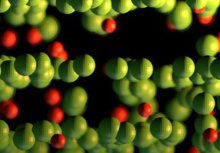Materials Science Glossary - B
β-stabilizer. Alloying element expanding the β-phase field in phase diagrams of Ti alloys and thereby lowering β/(α+β) transus.
β-Ti. High-temperature allotropic form of titanium with BCC crystal structure, stable above 882°C up to the melting point at atmospheric pressure.
β Ti alloy. Alloy with β-stabilizers wherein β-phase is the only phase constituent after air-cooling from temperatures above the β/(α + β) transus. Alloys with a small (∼5 vol%) amount of α-phase are related to the same group and termed near-β alloys. If the β →α transition does not evolve on air-cooling, these alloys are named metastable β alloys.
backscattered electron. Electrons that are elastically scattered in the direction opposite to the direction of the primary incoming beam. The yield of backscattered electrons increases with the atomic number of the substance studied. Backscattered electrons are used in SEM for gaining data on the topography, microstructure, and chemistry of the specimen surface, as well as for crystallographic studies.
bainite. An austenitic transformation product found in some steels and cast irons. It forms at temperatures between those at which pearlite and martensite transformations occur. The microstructure consists of -ferrite and a fine dispersion of cementite.
band gap energy (Eg). For semiconductors and insulators, the energies that lie between the valence and conduction bands; for intrinsic materials, electrons are forbidden to have energies within this range.
bake hardening. In Bake Hardening Steel artificial ageing leads to a decoration and blocking of dislocations with C-atoms resulting in a strength increase; especially the yield strength is raised. Bake Hardening describes the process of the industrial paint baking process. The final component is subjected to a thermal treatment in order obtain a high quality finish paint. During this annealing at temperatures between 140 and 200 °C for 10 to 90 minutes ageing processes occur in the material. Diffusion of interstitial atoms – typically 5 to 25 ppm C - takes place and these C-atoms tend to accumulate in the distorted lattice at dislocations. Therefore, the dislocations are blocked and higher strength is necessary for plastic yielding and further deformation. This anchoring mechanism is known as Cottrell-effect.
bifunctional. Designates monomers that may react to form two covalent bonds with other monomers to create a two-dimensional chainlike molecular structure.
block copolymer. A linear copolymer in which identical repeat units are clustered in blocks along the molecular chain.
body-centered cubic (BCC). A common crystal structure found in some elemental metals. Within the cubic unit cell, atoms are located at corner and cell center positions.
Bohr atomic model. An early atomic model in which electrons are assumed to revolve around the nucleus in discrete orbitals.
bonding energy. The energy required to separate two atoms that are chemically bonded to each other. It may be expressed on a per-atom basis or per mole of atoms.
BOP: Bond-order potential. A class of empirical (analytical) atomic potentials used in molecular dynamics and molecular statics simulations. Examples of such potentials include Tersoff, Brenner, Finnis-Sinclair, and the second-moment tight-binding potentials. They have the advantage over conventional molecular mechanics force fields in that they can, with the same parameters, describe several different bonding states of an atom, and thus to some extent may be able to describe chemical reactions correctly.
Bragg’s law. A relationship that stipulates the condition for diffraction by a set of crystallographic planes. More specific Bragg’s Law was introduced by Sir W.H. Bragg and his son Sir W.L. Bragg. The law states that when the x-ray is incident into a crystal surface layers, its angle of incidence will reflect back with a same angle of scattering. And, when the beam’s path difference is equal to a whole number of the applied wavelength, constructive interference will occur.
branched polymer. A polymer having a molecular structure of secondary chains that extend from the primary main chains.
brass. A copper-rich copper–zinc alloy.
brazing. A metal joining technique that uses a molten filler metal alloy having a melting temperature greater than about 425°C.
brittle fracture. Fracture that occurs by rapid crack propagation and without appreciable macroscopic deformation.
bronze. A copper-rich copper–tin alloy; aluminum, silicon, and nickel bronzes are also possible.
bronze age. The Bronze Age is the second part of the three-age system (Stone Age, Bronze Age, and Iron Age) for classifying and studying prehistoric societies, particularly the ancient societies of the Mediterranean and Near East. More broadly, the Bronze Age of any culture is the period during which the most advanced metalworking (at least in systematic and widespread use) in that culture uses bronze. This could either be based on the local smelting of copper and tin from ores, or trading for bronze from production areas elsewhere. Copper/tin ores are rare, as reflected in the fact that there were no tin bronzes in western Asia before 3000 BC. Many, though not all, Bronze Age cultures flourished in prehistory. Some cultures developed extensive written records during their Bronze Ages.
Burgers vector (b). A vector that denotes the magnitude and direction of the lattice distortion associated with a dislocation. It is determined by Burgers circuit around the dislocation core.


